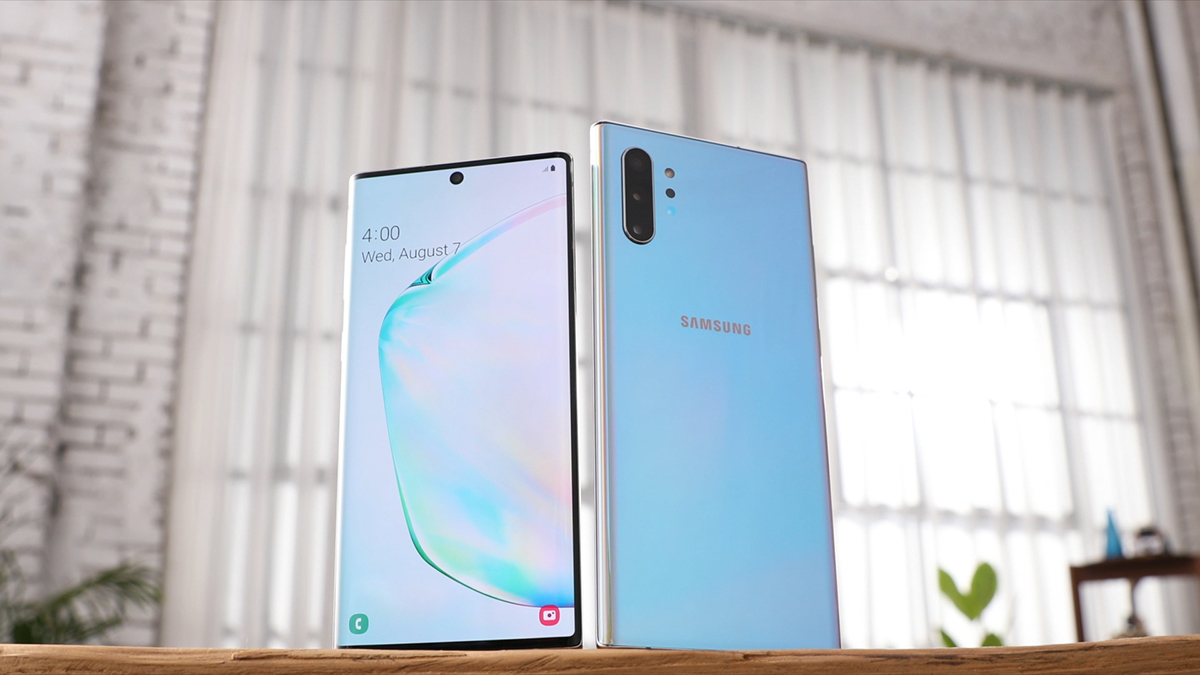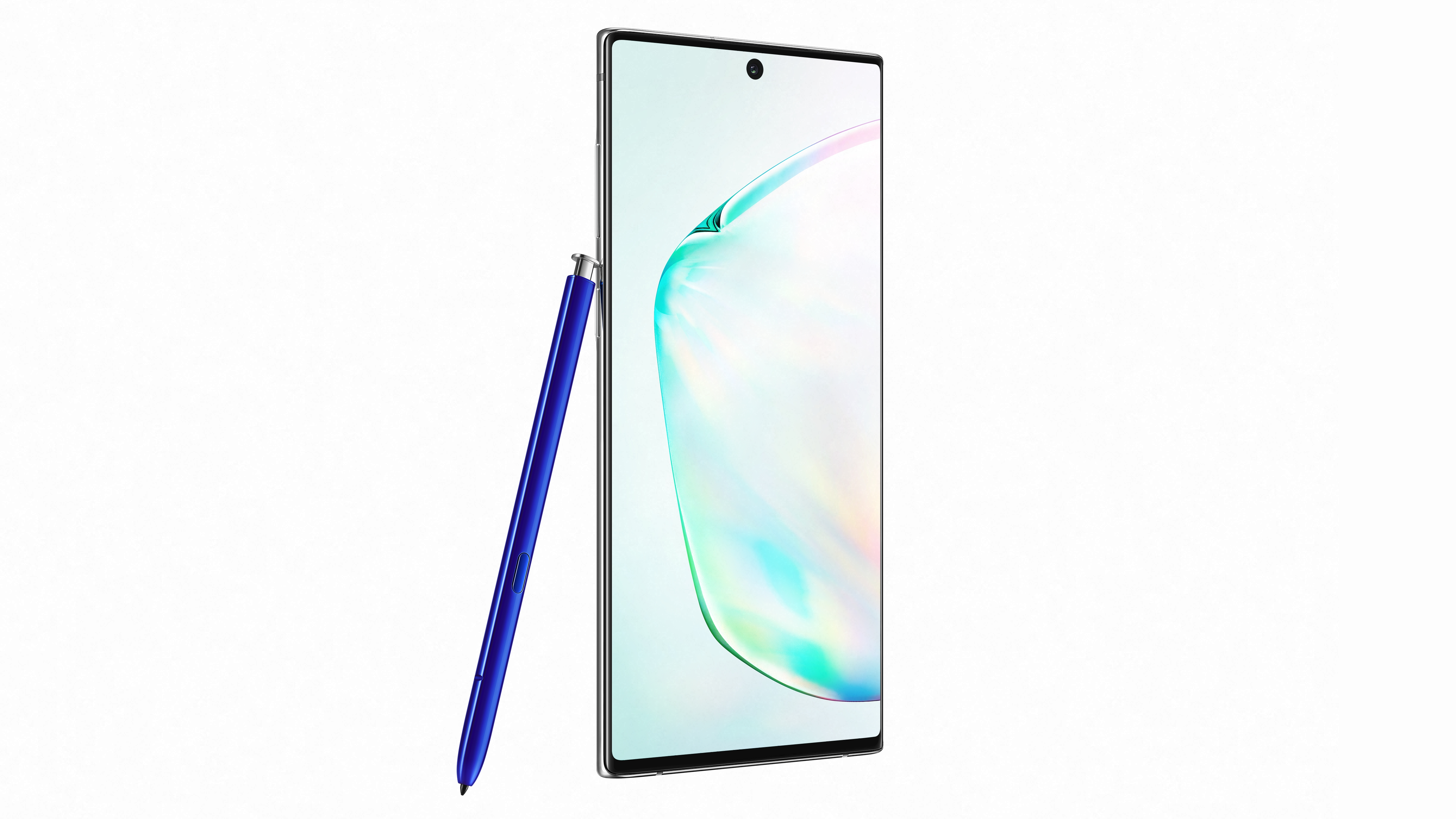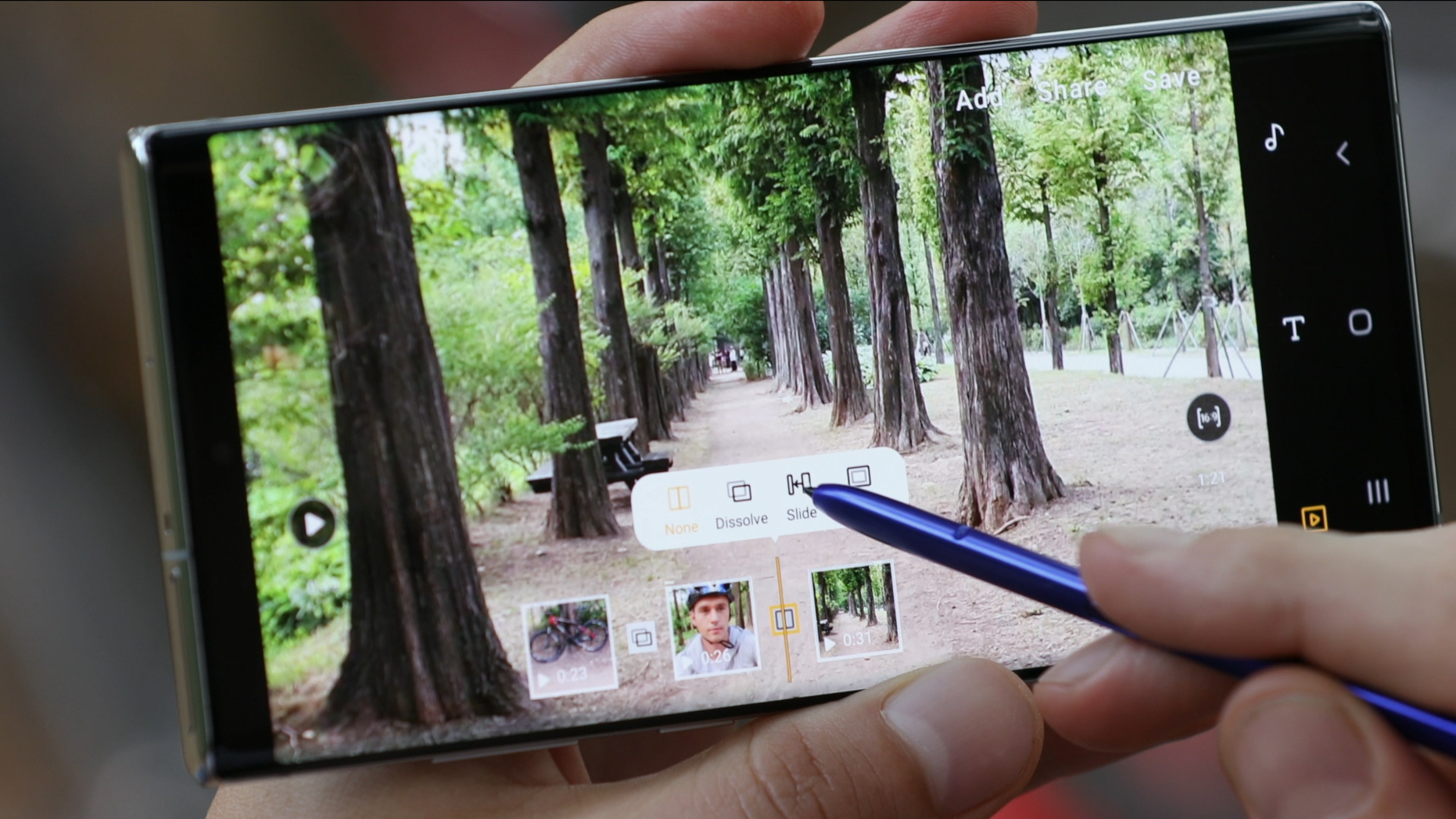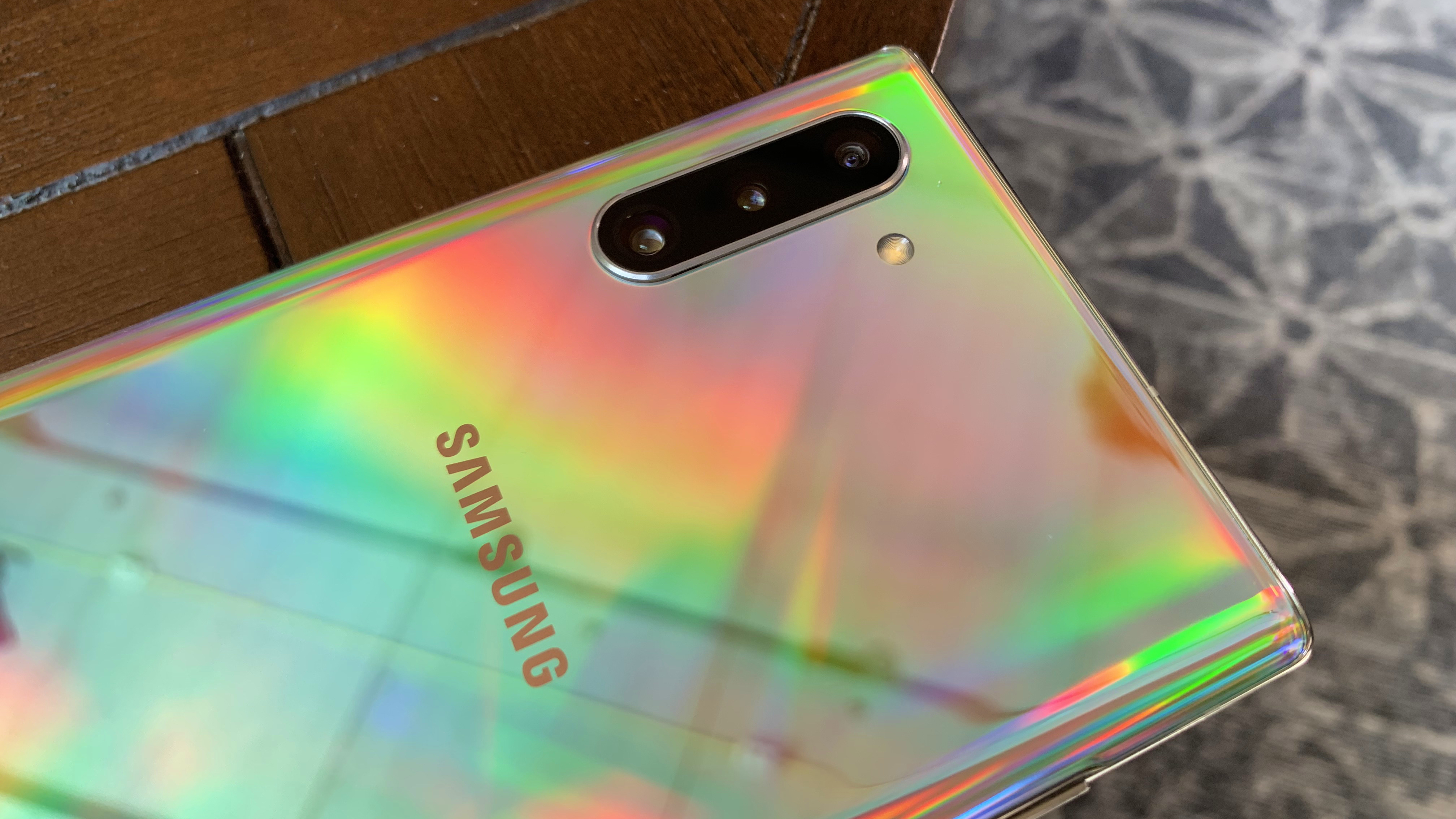Samsung Galaxy Note 10 review (early verdict): size really does matter
Galaxy Note 10 has an upgraded S Pen, new Infinity-O display, and improved camera with Live Focus video

Samsung's Galaxy Note series has always been known for its mammoth screen sizes, but the more compact design of the Galaxy Note 10 just feels right. The smaller footprint is infinitely more manageable and enjoyable. Unfortunately, opting for the smaller Note 10 means missing out on a few features you'll only find on the pricier Galaxy Note 10+, including more battery life, a MicroSD card slot for expandable storage, more RAM, faster charging, and support for 5G. For our money, the Note 10 is still the better overall package, but it's a shame you'll have to forgo a lot more than just screen real estate if you pick it up over the bigger Note 10+.
-
+
Perfect size
-
+
10-hour battery life on the S Pen
-
+
Stunningly versatile camera
-
+
Live Focus on photos and videos
-
-
No MicroSD for expandable storage
-
-
Less RAM and built-in storage than Note 10+
-
-
No 5G option in the UK
-
-
No 45W fast charging option
-
-
No 3.5mm headphone port
Why you can trust T3

Samsung Galaxy Note 10 Key Specs

Dimensions: 151 x 71.8 x 7.9mm
Weight: 168 g
Screen: 6.3-inch AMOLED, 1080 x 2280 at 401 ppi
CPU: Qualcomm Snapdragon 855
RAM: 8GB
Storage: 256GB – no MicroSD card for expandable storage
Battery: 3,500mAh
Cameras: 12MP main + 12MP telephoto + 16MP ultra-wide / 10MP selfie
OS: OneUI / Android 9.0 Pie
Samsung has taken the wraps off its new Galaxy Note 10 range. For the first time in years, the South Korean company has launched more than one handset for the flagship Galaxy Note line-up. While the deciding factor for most buyers will be the screen size, it’s far from the only differentiating feature between these two smartphones… but more on that later.
While the Galaxy Note 10+ packs the sort of thumb-straining screen you’d expect from the range that popularised phablets, the Galaxy Note 10 opts for a more conservative 6.3-inch display. It might seen odd to describe a 6.3-inch screen as conservation – after all, it’s bigger than both Galaxy S10e and Galaxy S10 – but the incredible work the Samsung R&D department has done to minimise the bezels around the display means this really does feel like a manageable handset.
- Samsung Galaxy Note 10+ review
- Samsung Note 10, Note 10+ unveiled with all-screen design, upgraded S Pen, and 5G
- Samsung Galaxy Note 10 vs Samsung Galaxy S10 Plus
Ahead of the Galaxy Unpacked launch, T3 had the chance to get our hands on the Galaxy Note 9 successors. What follows are our initial impressions on the handset. Check back for an in-depth review complete with a star rating in the near future.
Samsung Galaxy Note 10 review: Price, Release Date
Samsung Galaxy Note 10 will be available in three colours – Aura Glow, Aura Black, and Aura Pink. The Aura Glow is a shimmering blend of different colours. It’s incredibly reflective and appears in a different shade each time it catches the light.
In photographs, it can look similar to the shimmering finishes seen on the Huawei P30 series, but it’s not quite as pleasant as that. It’s too reflective to really let the colours shine, which is a shame as the comparable Prism White colour on the Galaxy S10 series that debuted earlier this year is stunning and proves Samsung can stand toe-to-toe with Huawei when it comes to this look.
Pre-orders are available online today, August 7, while the first smartphones will begin appearing on high street store shelves from August 23, 2019. Galaxy Note 10 starts from £899 for the 4G model with 8GB of RAM and 256GB of built-in storage, while the Galaxy Note 10+ costs £999 for the 256GB variant, and maxes-out at £1,199 for the 5G-enabled handset with 512GB of storage and 12GB of RAM.

Samsung Galaxy Note 10 review: Display, Design
Holding the Galaxy Note 10 in your palm, it just feels right. Sure, streaming the latest much-binge Netflix series everyone is talking about would undoubtedly be more enjoyable on the 6.8-inch panel found on the Note 10+, but is it really worth all the hassle that pocketing a display that size every day entails? After playing with the Galaxy Note 10 for a little while, we’re not convinced.
Get all the latest news, reviews, deals and buying guides on gorgeous tech, home and active products from the T3 experts
Samsung has done a phenomenal job whittling away the bezels around the AMOLED display on the Note 10. The flagship phone now enjoys a 93.2% screen-to-body ratio, up from 83.9% on the Note 9 – it’s the difference between the device feeling unwieldy and cumbersome, and manageable. As with the Galaxy S10 series, One UI deserves a lot of the credit here too.
The Android Pie-based software was designed to make expansive smartphone screens easier to use – especially one-handed. To do this, One UI shifts all the elements of the user interface that you’ll actually need to interact with – buttons, toggles, menu items – into the lower-third of the touchscreen where they can be easily reached, even for those with smaller hands.
Think of it like the Reachability feature Apple introduced a few years back, which temporarily drops the entire screen into the lower-half of the display, but applied across an entire user interface. Even swiping on the notification shade drops the quick action toggles far enough down the display that you won’t need to perform thumb-gymnastics to hit the right icon.
The comically-large titles at the top of the display look pretty odd – surely Samsung could’ve found something slightly more useful to do with all that extra space at the top of screen instead of just WordArt’ing every menu title like an overzealous Year 7 zhuzhing up their homework? But it’s a small price to pay for a generous 6.3-inch display that remains comfortable to use on-the-go.

With the Galaxy Note 10, Samsung has tweaked its Infinity-O design, relocating the O-shaped cut-out (hence the name) used to house the front-facing camera. While the Galaxy S10 series kept the hole-punch in the top right-hand corner of the screen and the Galaxy A8s squirrelled its into the top left, the Galaxy Note 10 wears its embedded camera loud and proud dead-centre.
At least there’s no dual-camera like the one featured on the Galaxy S10 Plus, which takes up an inordinate amount of space and feels like an outbreak of dead pixels has started in the corner of your screen. For our money, the new design is a little better.
The new hole-punch camera doesn’t get in the way of the small system icons found in the top left- and right-hand corners on every Android smartphone. And if the notch on the iPhone X has taught us anything, it’s that it’s very easy to get used to an intrusion in the middle of the screen.
That said, the cycloptic Note 10 can’t reasonably be described as beautiful – a word that definitely could be used for earlier iterations in the Galaxy Note series.
Unlocking the Galaxy Note 10 is handled with an in-display ultrasonic fingerprint scanner – just like the Galaxy S10 series. Samsung has moved the sensor a little higher up the frame this time around, so it falls in a much more natural position when holding the phone. Unfortunately, we weren't able to thoroughly test the accuracy or speed of the fingerprint scanner, but we were impressed with how well the technology worked – even when the screen was slick with rain – on the S10.

Samsung Galaxy Note 10 review: Camera
Selfies on the Galaxy Note 10 are handled by a 10MP camera with f/2.2. In our short time using the handset, photographs from the front-facing camera looked good – with plenty of detail that will survive more than a few edits before being posted to social media. Like the Galaxy S10 Plus, the Galaxy Note 10 supports Live Focus images from the front-facing camera, so you can add an artificial bokeh-style blur behind your face.
Samsung has also thrown-in a few wackier looks for those who want to stand-out from the endless sea of bokeh-filled selfies, including a new “glitch” effect that gives the background the appearance of a badly maintained VHS – with tracking and stuttering colours. It’s not something you’re likely to use all that often, but it’s a fun new addition nonetheless.
Since it’s entirely software-based, it’s possible these new effects will be rolled-out to the Galaxy S10 Plus and Galaxy S10 5G, which already boasts a number of similar effects for the depth-sensing feature, including a Zoom and Swirl look.
Unlike the Google Pixel 3, there’s no ultra-wide angle selfies to be found here. So, if you’re holidaying with a big group of friends, you’ll either have to resort to a timer, the remote shutter function included with the S Pen, or a selfie stick.
However, it’s on the back of the Note 10 where you’ll find the most significant changes, especially for those upgrading from the Note 9 or older. The Note 10 boasts a triple-camera system that combines a 12MP wide-angle camera with the same variable aperture technology seen on the Galaxy S10 range – allowing the camera to instinctively switch between f/1.4 and f/2.4 to capture images in challenging low light conditions, a 16MP ultra-wide with a 123° field of view, and finally, a 12MP telephoto camera that handles 2x optical zoom and Live Focus shots.
If that list sounds at all familiar, it’s because it’s the same mixture of ultra-wide, telephoto and dual-aperture found on the Galaxy S10 Plus – so you’ll find exactly the same photo options, including the artificial adjustable bokeh blur Live Focus photos.
Like the selfie camera, you’ll also get the same Live Focus options from the rear-facing set-up, including Glitch and Circles, which adds circular bokeh-style blur behind the subject. Like the Galaxy S10 5G, the Note 10 is capable of adding these Live Focus effects to video in real-time. Unlike the former, the new flagship handset handles the effect using software, although the results were seriously impressive in our brief time with the Note 10.
Samsung says the Note 10 has been designed to add artificial bokeh behind people and objects, so you won’t be limited to just faces like the software-led solution seen on the iPhone XR’s Portrait Mode, for example.

We’ll need to spend a lot more time with the Note 10 and it’s triple-camera to get a good handle on what it’s capable of, but the early signs are very, very promising. Photographs are packed with details – albeit not quite as sharp as what you’ll get out of a Pixel 3. As you’d expect from Samsung, the images are warmer and more vibrant than rival handsets from Google and Apple.
Unfortunately, the Note 10 misses out on the new patented DepthVision camera that you’ll find on the back of the Note 10+. This includes two separate sensors and is different from the Time Of Flight sensor found on the Galaxy S10 5G. Samsung says the new propriety system should offer better bokeh-style blur behind the subject in photos and videos.
It should also offer more accurate results when measuring distances, or placing computer generated objects into the real-world using Augmented Reality (AR) apps.
Samsung Galaxy Note 10 review: S Pen
The Galaxy Note simply wouldn’t be the Galaxy Note without an S Pen. The trademark stylus gets a modest update with the latest handset. The biggest new feature are Air Gestures, which uses the new six-axis sensors built into the S Pen to let you control features on the phone by waving it around in the air, like a Nintendo Wii controller.
For example, holding down the button built into the stem of the S Pen and flicking it upwards – like a trainee wizard at Hogwarts – switches between the front and rear-facing cameras. Coupled with the ability to use the S Pen to remotely trigger the shutter button introduced last year, the Galaxy Note 10’s rear-facing camera is entirely hands-free.
In our brief time with the Galaxy Note 10, Air Gestures felt pretty gimmicky. The technology itself works well and its impressive just how much smarts Samsung is now able to squeeze into the svelte stylus… but when was the last time you wanted to switch between the rear camera and the selfie camera using a flicking gesture a few metres from your handset? Yeah, us neither.

More interestingly, Samsung is opening up Air Gestures to third-party developers, so we’re likely to see some intriguing new applications surface in the Play Store over the coming months. Should the team behind Harry Potter: Wizards Unite integrate the stylus gestures to make for some truly immersive wand action, it could easily make the Galaxy Note 10 the definitive version of the mobile sensation, for example.
While the S Pen included with the Note 9 included the ability to remotely control keynote presentations, the 30-minute battery life meant you had to do some serious trimming to your TED talk to benefit from the new feature. That has been fixed this time around. The upgraded S Pen you’ll find bundled with the Galaxy Note 10 has a stunning 10 hour battery life and can recharge from flat in just 6 minutes.
Finally, Samsung has added a new stylus feature called AR Doodles. As the name suggests, this lets you scrawl on any faces displayed in the viewfinder with the hand-drawn crowns, glasses, facial, and presumably, comically-engorged genitals, using the S Pen. Samsung will keep the drawing adhered to the face as it moves. AR Doodle can be used for both photos and videos.

It’s a fun little feature and a great demo for the handset, but it does sit somewhat at odds with the productivity and business focus of the Galaxy Note series.
That said, even the most spreadsheet-obsessed amongst us need to switch off every now and again, and if drawing a pair of spectacles on a colleague’s face and watching it stick to them as they move around the room helps you keep a good work-life balance, then more power to you.
Samsung Galaxy Note 10 review: Specs, Other Features
As you’d expect from the flagship Galaxy Note range, there is no shortage of processing grunt beneath the bonnet of the Note 10. The next-generation phone is powered by 8GB of RAM, coupled with 256GB of built-in storage. There’s also a 3,500mAh battery that Samsung says is more than enough to keep the handset powered throughout the day and well into the evening, largely thanks to the power efficiencies of the new seven-nanometre Exynos 9825 chipset.
Unfortunately, only the larger Note 10+ has a microSD for expandable storage, so those hoping to increase the storage by an additional 1TB will have to plump for the costlier 6.8-inch model. Given that this is supposed to be a work powerhouse, that’s a little disappointing. Of course, 256GB of built-in storage isn’t anything to be sniffed at, but the lack of expandable storage does mean the handset isn’t as future-proof as some of the previous Galaxy Note entries.
Elsewhere, Note 10 includes sound tuned by AKG, which is plenty loud enough to enjoy a YouTube video without headphones, Wireless PowerShare – which allows you to charge Galaxy Buds or any other Qi-compatible gadget by placing it on the back of the handset, IP68 water and dust resistance, and support for Wi-Fi 6, which means you’re future-proofed as your home and work router are upgraded in the coming years.
Samsung Galaxy Note 10 comes with a 25W fast wired charger in the box and now supports up to 15W fast wireless with the correct Qi wireless pads, so there are plenty of options when it comes to quickly topping-up the handset. Unfortunately, only the pricier Note 10+ benefits from the all-new super-speedy 45W wired charging, which Samsung claims can refill your smartphone with enough battery for an entire day with just 30 minutes plugged into the wall.

It’s a little disappointing to see the Galaxy Note 10 miss out on quite so many of the features included with its costlier cousin. It would be better if the only deciding factor between the two handsets in the Galaxy Note 10 range was what screen size do you prefer? How important is the size of the handset itself to you? Alas, plumping for the 6.8-inch Galaxy Note 10+ also means you’ll benefit from an all-new DepthVision camera system for improved AR, expandable storage, a bigger battery with faster charging, more RAM and more built-in storage, too.
One thing both the Galaxy Note 10 and Note 10+ have in common is a missing 3.5mm headphone port. Yes, it’s true – after years of roundly mocking Apple and other rivals for dropping the audio port, Samsung has ditched the once-ubiquitous connector. The company says it removed the port because it needed the space inside the handset to squeeze more battery life into the new svelte frame. OnePlus has used a similar excuse in the past.
We’ll thoroughly test the battery life in our full, in-depth review to see if that argument holds any water… but in the meantime, the missing port is so common these days that you’re unlikely to be phased. In the box, Samsung will throw-in a pair of USB-C wired AKG headphones, but no dongle. Of course, this can be bought separately from the Samsung Store, but the additional purchase is likely to frustrate people with wired 3.5mm headphones they’re reticent to ditch for a new phone.

Samsung Galaxy Note 10 review: Our Early Verdict
The Galaxy Note series has always been known for its uncompromising power, trademark stylus, and mammoth screen size. But picking up the Note 10 for the first time, the new compact design just feels right.
Samsung is known for pushing the envelope with some pretty out-there designs – the widespread mockery of the 'phablet' size of the first Galaxy Note, the cynicism around the first Edge version with a curved glass display, to name just a few. But easily the most innovative aspect of the Galaxy Note 10 is the restraint.
The smaller footprint – thanks largely to the Infinity-O design and One UI operating system – is infinitely more manageable than the gargantuan Note 10+. And as a result, it's more enjoyable to pick-up and use.
Unfortunately, opting for that superior, smaller size means missing out on a few key features that you'll find on the pricier Galaxy Note 10+, including the increased battery life, expandable storage, all-new DepthVision camera system, more RAM, faster wired charging option, and support for 5G networks.
Taken on their own, none of these are must-have features that justify immediately plumping for the Note 10+. But put together, it feels like Note 10 owners will be shortchanged with a compromised experience compared to those with the Note 10+.
In our short time with the Samsung Galaxy Note 10, we've been deeply impressed.
It’s a gorgeous smartphone with a stunning edge-to-edge display, some interesting new camera tricks, and some serious firepower. However, it’s a shame those who opt for the Note 10 instead of the Galaxy Note 10+ will miss out on so much more than just a little extra screen real estate. Especially since the Galaxy Note 10 is a better overall package.
Samsung Galaxy Note 10 review: News, Updates
Since we published our Galaxy Note 10 review, some new details about the Samsung handset have emerged. We'll keep you posted about all of the latest updates here, in case they change how you feel about the handset...
August 13, 2019: Samsung has now confirmed that Galaxy Note 10+ will only ship with a USB-C to USB-C cable in the box – not the USB-C to USB A that it shipped with the Galaxy Note 9. What does that mean? Well, if you don't have a laptop or desktop computer with a USB-C port handy – you're going to struggle to connect your shiny new Samsung-branded phone to it. It also means you're not going to be able to connect the charging cable to any old USB-A wall plug that you've likely got sat around from various previous purchases. It's not a dealbreaker, but it might mean you're keen to add a separate cable or adapter to your basket at check-out.

As a former Staff Writer for T3, Aaron writes about almost anything shiny and techie. When he’s not barking orders at Alexa-powered microwaves or gawping at 5G speed tests, Aaron covers everything from smartphones, tablets and laptops, to speakers, TVs and smart home gadgets. Prior to joining T3, Aaron worked at the Daily Express and and MailOnline.